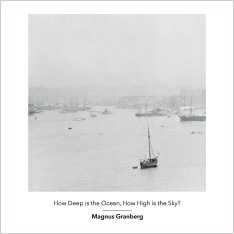 Magnus Granberg’s fourth composition for Another Timbre—and second album under his own name—borrows its title and some of its musical material from Irving Berlin’s "How Deep is the Ocean," written in 1932 and recorded through the years by such luminaries as Ella Fitzgerald, Judy Garland, and Julie Andrews. Anyone who just listens to the music, however, might not realize that, because Granberg also looked to Satie’s "Deuxième Préludes du Nazaréen" for rhythmic inspiration. "Nazaréen’s" slow, even movements and muted dynamics are an obvious model for the suspended animation of Granberg’s hazy textures. The link to Berlin’s jazz standard resides less in its melodies and more in its lyrics, which pose a series of questions as an answer to the song’s first line, "How much do I love you?" Nobody sings on How Deep is the Ocean, How High is the Sky?, and it doesn’t pose anything like an obvious question, but the album’s unusual instrumentation and constantly shifting sound chip away at easy musical distinctions in the same manner that Berlin’s lyrics try to answer a question for which words are rarely sufficient.
Magnus Granberg’s fourth composition for Another Timbre—and second album under his own name—borrows its title and some of its musical material from Irving Berlin’s "How Deep is the Ocean," written in 1932 and recorded through the years by such luminaries as Ella Fitzgerald, Judy Garland, and Julie Andrews. Anyone who just listens to the music, however, might not realize that, because Granberg also looked to Satie’s "Deuxième Préludes du Nazaréen" for rhythmic inspiration. "Nazaréen’s" slow, even movements and muted dynamics are an obvious model for the suspended animation of Granberg’s hazy textures. The link to Berlin’s jazz standard resides less in its melodies and more in its lyrics, which pose a series of questions as an answer to the song’s first line, "How much do I love you?" Nobody sings on How Deep is the Ocean, How High is the Sky?, and it doesn’t pose anything like an obvious question, but the album’s unusual instrumentation and constantly shifting sound chip away at easy musical distinctions in the same manner that Berlin’s lyrics try to answer a question for which words are rarely sufficient.
Unlike anything Irving Berlin ever employed, Magnus Granberg’s orchestra is made up of nine musicians, not including himself, more than half of whom play an instrument that is approximately 400 years old. The chitarrone, bass recorder, viola de gamba, spinet, and baroque violin stick out almost as historical curiosities, especially on an album that sounds like it belongs more to this century than to anything in even the last 150 years, and which counts analogue synthesizer, prepared piano, various electronics, and unspecified objects among its instruments.
In an interview on the Another Timbre website, Granberg explains that the spinet player, Christoph Schiller, suggested using period instruments to reflect the music scene in and around Basel, where the album was recorded. The degree to which his suggestion succeeds depends on what the listener knows about Basel, Switzerland and the Schola Cantorum Basiliensis. The more immediate impression is that of deliberation and careful listening. Sounds often come one at a time, or in small increments, and at low volumes. Gestures wind up into the air then drop into silence like they’re tied to bowling balls. Mouse-like scampering occupies the place normally reserved for percussion and very slight electronic distortions murmur in the background as if they’re trying to be quiet during a lecture. The formality betrays the degree to which the music is composed, the seeming randomness of its development speaks to the improvisation on display. The album’s middle portion, especially around the 28 minute mark, is particularly formal. The sequence of events could have been scored for a radio play or a very tense theatrical scene, but it’s just one passing moment among many, perhaps an example of synchronicity and perhaps a calculated outcome.
The second, maybe less obvious impression is that of distillation, or of haunting. Satie and Berlin haunt the music in the sense that Granberg invited them to haunt it, but their presence isn’t obvious. Knowing that they are there at all helps only a little. Their remains are neither purified nor concentrated in the resulting concoction. Instead they are experienced at a remove, either as historical fact or as concealed musical ingredient. What’s left is a ghostly expression of emptiness, of instruments played in a museum, or of music sealed behind glass, which is not to say that it sounds artificial. At times the opposite is true: the music seems to play itself, or it presents itself as a physical fact, the consequence of gravity, solar flares, jet streams, and tidal forces. The human element slips into the depths and the elemental features of music, condensed into a few representative examples, float to the surface—where they tick away like a perfectly engineered clock in an empty room.
samples:
- How Deep is the Ocean, How High is the Sky? [Sample 1]
- How Deep is the Ocean, How High is the Sky? [Sample 2]
- How Deep is the Ocean, How High is the Sky? [Sample 3]
 
Read More

